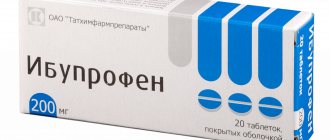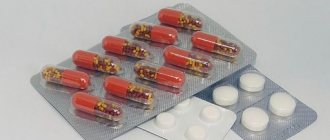Omacor
Omega-3 polyunsaturated fatty acids - eicosapentaenoic acid (EPA) and docosahexaenoic acid (DHA) - are classified as essential fatty acids (NEFA). Omacor is active against plasma lipids, reducing the concentration of triglycerides as a result of reducing the concentration of very low density lipoproteins (VLDL). In addition, it affects blood pressure and hemostasis. Omacor reduces the synthesis of triglycerides in the liver, since EPA and DHA are less active substrates for the enzymes responsible for the synthesis of triglycerides, and they inhibit the esterification of other fatty acids.
A decrease in triglyceride concentration is also facilitated by increased P-oxidation of fatty acids in liver peroxisomes, thereby reducing the amount of free fatty acids available for triglyceride synthesis. Inhibition of this synthesis reduces VLDL levels.
Omacor increases low-density lipoprotein (LDL) cholesterol levels in some patients with hypertriglyceridemia. The increase in high-density lipoprotein (HDL) cholesterol concentrations is minimal, significantly lower than after fibrates, and not consistent.
The duration of the lipid-lowering effect when taking Omacor for more than 1 year has not been studied. Otherwise, there is no convincing evidence that lowering triglyceride levels reduces the risk of coronary heart disease.
During therapy with Omacor, a decrease in the synthesis of thromboxane A2 and a slight increase in blood clotting time were observed. No significant effects on other coagulation factors were observed.
The results of the GISSI-Prevenzione clinical trial, obtained over 3.5 years of follow-up, showed a significant reduction in the relative risk of mortality from all causes, non-fatal myocardial infarction and non-fatal stroke by 15% ([2-26] p = 0.0226) in patients after recently suffered myocardial infarction, taking the drug Omacor 1 g per day.
Additionally, the relative risk of death due to cardiovascular disease, non-fatal myocardial infarction and non-fatal stroke was reduced by 20% ([5-32] p=0.0082). The results of another clinical trial, GISSI-Heart Failure, in which patients with chronic heart failure received Omacor 1 g per day for an average of 3.9 years, showed a reduction in the relative risk of mortality from all causes by 9% (p = 0.041), reduction in the relative risk of mortality from all causes and hospitalization due to cardiovascular pathologies by 8% (p = 0.009), reduction in the relative risk of primary hospitalization due to ventricular arrhythmias by 28% (p = 0.013).
The whole truth about hormone replacement therapy
Murzaeva Irina Yurievna
Endocrinologist, Preventive Medicine Doctor
September 28, 2014
I take the liberty to describe the benefits and fears of prescribing hormone replacement therapy (HRT). I assure you - it will be interesting!
Menopause, according to modern science, is not health, it is a disease. Its characteristic specific manifestations are vasomotor instability (hot flashes), psychological and psychosomatic disorders (depression, anxiety, etc.), urogenital symptoms - dry mucous membranes, painful urination and nocturia - “night trips to the toilet”. Long-term effects: CVD (cardiovascular disease), osteoporosis (low bone density and fractures), osteoarthritis and Alzheimer's disease (dementia). As well as diabetes and obesity.
HRT in women is more complex and multifaceted than in men. If a man needs only testosterone for replacement, then a woman needs estrogens, progesterone, testosterone, and sometimes thyroxine.
HRT uses smaller doses of hormones than hormonal contraceptives. HRT drugs do not have contraceptive properties.
All the materials below are based on the results of a large-scale clinical study of HRT in women: Womens Health Initiative (WHI) and published in 2012 in the consensus on hormone replacement therapy of the Research Institute of Obstetrics and Gynecology. IN AND. Kulakova (Moscow).
So, the main postulates of HRT.
- You can start taking HRT for another 10 years after the cessation of your menstrual cycle (taking into account contraindications!). This period is called the “window of therapeutic opportunity.” Over 60 years of age, HRT is not usually prescribed. How long is HRT prescribed? – “As much as needed” To do this, in each specific case, you need to decide on the purpose of using HRT in order to determine the timing of HRT. The maximum period for using HRT: “last day of life – last pill.”
- The main indications for HRT are vasomotor symptoms of menopause (these are menopausal manifestations: hot flashes), and urogenital disorders (dyspariunia - discomfort during sexual intercourse, dry mucous membranes, discomfort during urination, etc.)
- With the right choice of HRT, there is no evidence of an increase in the incidence of breast and pelvic cancer ; the risk may increase with a duration of therapy of more than 15 years! HRT can also be used after treatment of stage 1 endometrial cancer, melanoma, and ovarian cystadenomas.
- When the uterus is removed (surgical menopause), HRT is given as estrogen monotherapy.
- When HRT is started on time, the risk of cardiovascular diseases and metabolic disorders is reduced. That is, during hormone replacement therapy, normal metabolism of fats (and carbohydrates) is maintained, and this prevents the development of atherosclerosis and diabetes mellitus, since the deficiency of sex hormones in postmenopause aggravates existing ones and sometimes provokes the onset of metabolic disorders.
- The risk of thrombosis increases when using HRT with a BMI (body mass index) = more than 25, that is, if you are overweight!!! Conclusion: excess weight is always harmful.
- The risk of thrombosis is higher in women who smoke. (especially when smoking more than 1/2 packs per day).
- It is advisable to use metabolically neutral gestagens in HRT (this information is more for doctors)
- Transdermal forms (external, that is, gels) are preferable for HRT ; they exist in Russia!
- Psycho-emotional disorders often prevail in menopause (which does not allow one to discern a psychogenic disease behind their “mask”). Therefore, HRT can be given for 1 month for trial therapy for the purpose of differential diagnosis with psychogenic diseases (endogenous depression, etc.).
- In the presence of untreated arterial hypertension, HRT is possible only after stabilization of blood pressure.
- Prescription of HRT is possible only after normalization of hypertriglyceridemia** (triglycerides are the second, after cholesterol, “harmful” fats that trigger the process of atherosclerosis. But transdermal (in the form of gels) HRT is possible against the background of elevated triglyceride levels).
- In 5% of women, menopausal symptoms persist for 25 years after the cessation of the menstrual cycle. HRT is especially important for them to maintain normal well-being.
- HRT is not a method of treating osteoporosis, it is a method of prevention (it should be noted that it is a cheaper method of prevention than the cost of treating osteoporosis itself).
- Weight gain often accompanies menopause , sometimes an additional + 25 kg or more, this is caused by a deficiency of sex hormones and related disorders (insulin resistance, impaired carbohydrate tolerance, decreased insulin production by the pancreas, increased production of cholesterol and triglycerides by the liver). This is collectively called menopausal metabolic syndrome. Timely prescribed HRT is a way to prevent menopausal metabolic syndrome (provided that it did not exist before, before menopause!)
- Based on the type of menopausal symptoms, it is possible to determine which hormones a woman lacks in her body, even before taking blood for a hormonal analysis. According to these signs, menopausal disorders in women are divided into 3 types: a) type 1 - only estrogen deficiency: weight is stable, no abdominal obesity (at the abdominal level), no decreased libido, no depression and urinary disorders and decreased muscle mass, but there is menopausal hot flashes, dry mucous membranes (+dysparium), and asymptomatic osteoporosis; b) type 2 (only androgen-deficient, depressive) if a woman has a sharp increase in weight in the abdominal area - abdominal obesity, increasing weakness and loss of muscle mass, nocturia - “night urge to go to the toilet”, sexual disorders, depression, but no hot flashes and osteoporosis according to densitometry (this is an isolated lack of “male” hormones); c) type 3, mixed, estrogen-androgen deficiency: if all the previously listed disorders are expressed - hot flashes and urogenital disorders are pronounced (dysparunia, dry mucous membranes, etc.), a sharp increase in weight, loss of muscle mass, depression, weakness - then there is not enough both estrogen and testosterone, both of which are required for HRT. It cannot be said that any of these types is more favorable than the other. **Classification based on materials from Apetov S.S.
- The question of the possible use of HRT in the complex treatment of stress urinary incontinence in menopause should be decided individually.
- HRT is used to prevent cartilage degradation and, in some cases, to treat osteoarthritis. An increase in the incidence of osteoarthritis with multiple joint lesions in women after menopause indicates the involvement of female sex hormones in maintaining the homeostasis of articular cartilage and intervertebral discs.
- Estrogen therapy has been shown to be beneficial for cognitive function (memory and attention).
- Treatment with HRT prevents the development of depression and anxiety , which often occurs with menopause in women predisposed to it (but the effect of this therapy occurs provided that HRT therapy is started in the first years of menopause, or better yet, premenopause).
- I no longer write about the benefits of HRT for a woman’s sexual function, aesthetic (cosmetological) aspects - prevention of “sagging” of the skin of the face and neck, prevention of worsening wrinkles, gray hair, tooth loss (from periodontal disease), etc.
Contraindications to HRT:
Main 3:
- History of breast cancer, current or suspected; If there is a hereditary history of breast cancer, a woman needs to undergo a genetic test for the gene for this cancer! And if the risk of cancer is high, HRT is no longer discussed.
- History or current history of venous thromboembolism (deep vein thrombosis, pulmonary embolism) and current or history of arterial thromboembolic disease (eg, angina pectoris, myocardial infarction, stroke).
- Liver diseases in the acute stage.
Additional:
- estrogen-dependent malignant tumors, for example, endometrial cancer or if this pathology is suspected;
- bleeding from the genital tract of unknown etiology;
- untreated endometrial hyperplasia;
- uncompensated arterial hypertension;
- allergy to active substances or to any of the components of the drug;
- cutaneous porphyria;
- dysregulated type 2 diabetes mellitus
Examinations before prescribing HRT:
- Taking an anamnesis (to identify risk factors for HRT): examination, height, weight, BMI, abdominal circumference, blood pressure.
- Gynecological examination, collection of smears for oncocytology, ultrasound of the pelvic organs.
- Mammography
- Lipidogram, blood sugar, or sugar curve with 75 g of glucose, insulin with calculation of the HOMA index
- Additionally (optional):
- analysis for FSH, estradiol, TSH, prolactin, total testosterone, 25-OH-vitamin D, ALT, AST, creatinine, coagulogram, CA-125
- Densitometry (for osteoporosis), ECG.
- Individually – Doppler ultrasound of veins and arteries
About the drugs used in HRT.
In women 42-52 years old with a combination of regular cycles with cycle delays (as a phenomenon of premenopause), who need contraception, who do not smoke!!!, you can use contraception instead of HRT - Jess, Logest, Lindinet, Mercilon or Regulon / or use an intrauterine system — Mirena (in the absence of contraindications).
Then they switch to HRT in a cyclic mode (with menstrual bleeding), and when the cycle stops, they switch to a continuous regimen of therapy.
Cutaneous etrogens (gels):
Divigel 0.5 and 1 g 0.1%, Estrogel
Combined E/G drugs for cyclic therapy: Femoston 2/10, 1/10, Climinorm, Divina, Trisequence
Combined E/G preparations for continuous use: Femoston 1/2.5 conti, Femoston 1/5, Angelique, Klmodien, Indivina, Pauzogest, Klimara, Proginova, Pauzogest, Ovestin
Tibolone
Gestagens: Duphaston, Utrozhestan
Androgens: Androgel, Omnadren-250
Alternative treatments include
herbal preparations: phytoestrogens and phytohormones. Data on the long-term safety and effectiveness of this therapy are insufficient.
In some cases, a one-time combination of hormonal HRT and phytoestrogens is possible. (for example, with insufficient relief of hot flashes by one type of HRT).
Women receiving HRT should visit their doctor at least once a year. The first visit is scheduled 3 months after the start of HRT. The doctor will prescribe the necessary examinations for monitoring HRT, taking into account the characteristics of your health!
Important! Message from the site administration about questions on the blog:
Dear readers! By creating this blog, we set ourselves the goal of giving people information on endocrine problems, diagnostic methods and treatment. And also on related issues: nutrition, physical activity, lifestyle. Its main function is educational.
Within the framework of the blog, in answering questions, we cannot provide full-fledged medical consultations; this is due to both the lack of information about the patient and the doctor’s time spent in order to study each case. Only general answers are possible in the blog. But we understand that not everywhere it is possible to consult with an endocrinologist at your place of residence; sometimes it is important to get another medical opinion. For such situations, when a deeper dive and study of medical documents is needed, at our center we have a format for paid correspondence consultations on medical documentation.
How to do it? Our center’s price list includes a correspondence consultation on medical documentation, costing 1,200 rubles. you can send scans of medical documents, a video recording, a detailed description, everything that you consider necessary regarding your problem and questions to which you want answers. The doctor will see if the information provided can give a full conclusion and recommendations. If yes, we will send the details, you will pay, and the doctor will send a report. If, based on the documents provided, it is impossible to give an answer that could be considered as a doctor’s consultation, we will send a letter stating that in this case, absentee recommendations or conclusions are impossible, and, of course, we will not take payment.
Sincerely, Administration of the Medical







